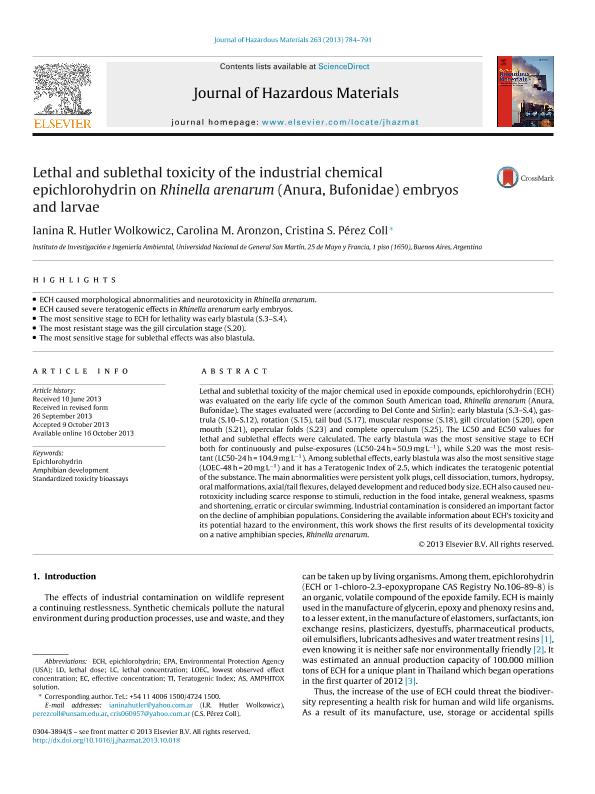Artículo
Lethal and sublethal toxicity of the industrial chemical epichlorohydrin on Rhinella arenarum (Anura, Bufonidae) embryos and larvae
Fecha de publicación:
12/2013
Editorial:
Elsevier Science
Revista:
Journal of Hazardous Materials
ISSN:
0304-3894
Idioma:
Inglés
Tipo de recurso:
Artículo publicado
Clasificación temática:
Resumen
Lethal and sublethal toxicity of the major chemical used in epoxide compounds, epichlorohydrin (ECH) was evaluated on the early life cycle of the common South American toad, Rhinella arenarum (Anura, Bufonidae). The stages evaluated were (according to Del Conte and Sirlin): early blastula (S.3–S.4), gastrula (S.10–S.12), rotation (S.15), tail bud (S.17), muscular response (S.18), gill circulation (S.20), open mouth (S.21), opercular folds (S.23) and complete operculum (S.25). The LC50 and EC50 values for lethal and sublethal effects were calculated. The early blastula was the most sensitive stage to ECH both for continuously and pulse-exposures (LC50-24 h = 50.9 mg L−1), while S.20 was the most resistant (LC50-24 h = 104.9 mg L−1). Among sublethal effects, early blastula was also the most sensitive stage (LOEC-48 h = 20 mg L−1) and it has a Teratogenic Index of 2.5, which indicates the teratogenic potential of the substance. The main abnormalities were persistent yolk plugs, cell dissociation, tumors, hydropsy, oral malformations, axial/tail flexures, delayed development and reduced body size. ECH also caused neurotoxicity including scarce response to stimuli, reduction in the food intake, general weakness, spasms and shortening, erratic or circular swimming. Industrial contamination is considered an important factor on the decline of amphibian populations. Considering the available information about ECH's toxicity and its potential hazard to the environment, this work shows the first results of its developmental toxicity on a native amphibian species, Rhinella arenarum.
Palabras clave:
Epiclohidrina
,
Toxicidad
,
Desarrollo Embrilarval
,
Anfibios
Archivos asociados
Licencia
Identificadores
Colecciones
Articulos(SEDE CENTRAL)
Articulos de SEDE CENTRAL
Articulos de SEDE CENTRAL
Citación
Hutler Wolkowicz, Ianina Ruth; Aronzon, Carolina Mariel; Perez Coll, Cristina Silvia; Lethal and sublethal toxicity of the industrial chemical epichlorohydrin on Rhinella arenarum (Anura, Bufonidae) embryos and larvae; Elsevier Science; Journal of Hazardous Materials; 263; 2; 12-2013; 784-791
Compartir
Altmétricas




